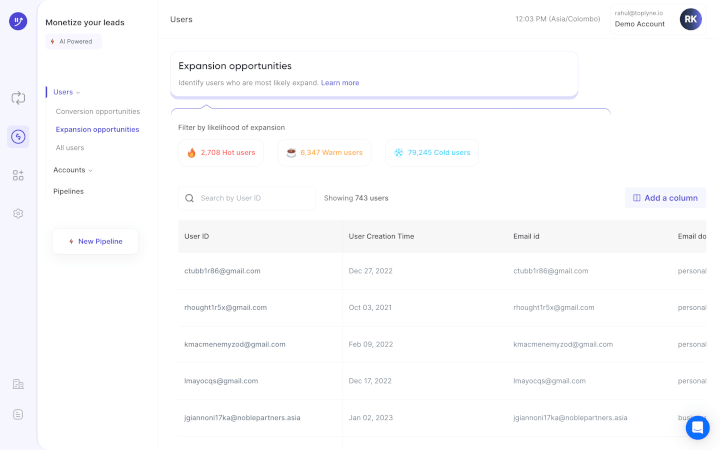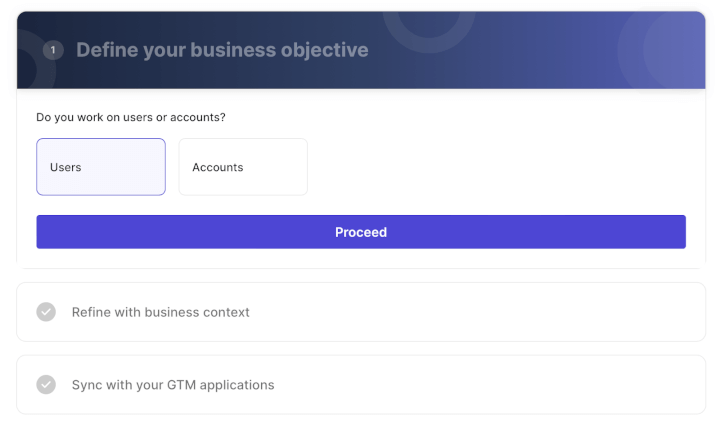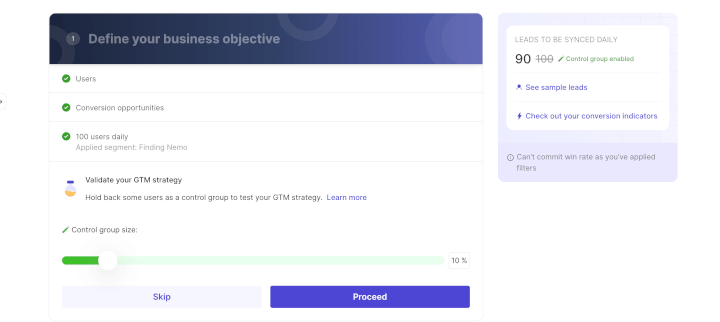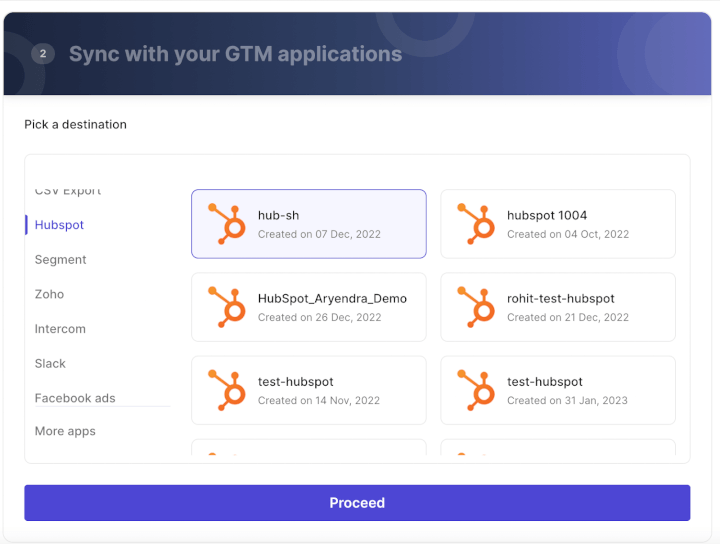12 Vital B2B Growth Metrics To Start Tracking Yesterday

Want to grow your revenue or customer base?
Tracking B2B growth metrics is a surefire way to assess your company's performance and understand if it's headed in the right direction.
If you notice things going downhill, you can quickly implement measures to reverse business outcomes.
But which B2B sales and marketing metrics matter the most?

Don’t worry!
Your search for the right B2B growth metrics will be easier than your search for Monday motivation. 😐
In this article, we’ll highlight 12 B2B growth metrics that you simply can’t afford to ignore. Additionally, we’ll introduce you to a tool that can help ramp up your revenue growth by identifying every high-quality lead.
Let’s go!
Twelve Critical B2B Growth Metrics for Your SaaS Company
Ready to decode some B2B SaaS metrics for growth?
Here are the top 12 B2B growth metrics that you should keep a close eye on 👀:
1. MQL to PQL Conversion Rate
A marketing qualified lead (MQL) engages with your B2B marketing material (blogs, email marketing, newsletters, etc.)
This happens when:
- The customer fills out a form.
- Downloads the free ebook.
- Registers for software demos.
- Clicks on the website CTAs.
- Subscribes to your newsletter.
A product qualified lead (PQL) is someone who has experienced your product’s value either through a free trial or a free plan.
The MQL to PQL conversion rate tracks the number of MQLs that eventually convert into PQLs.
Here’s the formula for MQL to PQL conversion rate:

Got a low conversion rate?
Here’s a tip to put you in the lead 😉:
Add a CTA prompting users to check out the free trial in your newsletters or other marketing resources.
If your product has that WOW factor and provides a fantastic user experience during the free trial, you’ll have more MQLs willing to make the jump and try your product.
2. Sales Cycle Length
Sales cycle length is the time your sales team takes to convert a customer and close the sale. It usually varies depending on the product’s price, complexity, and the number of individuals involved in the decision-making process.
Here’s the formula for sales cycle length:

One way B2B sales teams can speed up the sales cycle is by clearly quoting the price (very) early on and keeping it consistent.
Keeping your customers in the dark about additional costs only increases their consideration time, stretching your sales cycle by days, weeks, and months!

3. Lead to Customer Conversion Rate
Any sales rep or B2B marketer has spent a few sleepless nights wondering:
How many leads do we need to get one new customer?
For this, you need to calculate the lead to customer conversion rate:

Say your conversion rate is 10%, and your monthly target is 20 new customers. The formula states you'll need at least 200 leads to hit your target.
This metric helps you measure the effectiveness of your lead management process, including your lead sources and the types of leads you get.
Remember, low-quality B2B leads you down a rabbit hole! 🍥

Take proactive measures to increase conversions.
What do we mean?
Use Google Analytics data to review your digital marketing performance across multiple channels and assess user behavior. Additionally, you can rely on Toplyne to help you spot and nurture high-intent users who are ready to convert.
4. Customer Acquisition Cost (CAC)
Customer acquisition cost is the money spent on sales and marketing to gain one new customer for your SaaS business.
Here’s the formula for customer acquisition cost:

For a better profit margin and increased revenue, companies always aim to reduce the customer acquisition cost.
How do you do this?
Get your customers hooked on your product and deliver a user experience that keeps them coming back for more!
And when your B2B product speaks for itself, you can spend less on your sales and marketing effort and lower the customer acquisition cost.
5. Average Deal Size
Average deal size is the average amount of money you make per deal that you close in a specific period (a month, a quarter, or a year).
Here’s the formula for average deal size:

This B2B sales metric helps you create accurate projections for revenue growth to determine if you can approve that Christmas bonus for your employees!
Here’s how your sales team and marketing team can help increase your average deal size:
- Focus your B2B marketing efforts on the type of deals you’re looking for.
- Communicate fixed prices for long-term contracts.
- Filter out low-quality leads, so your B2B sales teams can focus only on high-value customers. Psst! Toplyne can help you identify high-quality leads and tell you what strategies to use to get them to convert!
What can every B2B marketer and sales rep in your company expect after implementing the above strategies?

6. Sales Pipeline Velocity
A sales pipeline outlines where customers are in the buying process, and a sales cycle refers to the series of steps involved in selling the product to a customer.
Sales pipeline velocity measures how quickly leads move through your sales pipeline and how much value new customers generate over a specific time.
Here’s the formula for this B2B sales metric:

To boost the sales pipeline velocity:
- Increase the number of sales opportunities. But don’t clog your pipeline with poor leads. Prioritize viable sales opportunities that have a real chance of driving revenue.
- Enhance the conversion rate (win rate) by closely assessing the client's pain points and developing a product that suits their needs.
- Optimize deal size by providing additional value to your users, like product add-ons and exclusive content releases.
- Speed up the sales cycle by updating your CRM database consistently. This way, your B2B sales teams won’t waste time with outdated contacts.
7. Average Revenue Per Customer (ARPC)
Average revenue per customer is the revenue generated per account.
Here’s the formula for average revenue per customer:

A low ARPC may indicate that you’re targeting too many low-revenue customers, and that you need to extract more revenue from your B2B product.
It may also mean that you need to improve your upselling and cross-selling strategies. In others, poke your marketing team and sales team to step up their game!
The higher the ARPC, the better the chances of extracting more cash in the future.
To improve the ARPC, use upselling (persuade users to upgrade to a more expensive plan offering advanced functionalities) and cross-selling (ask users to purchase related items) strategies.
8. Monthly Recurring Revenue (MRR)
Monthly recurring revenue measures the total monthly income your SaaS business expects to earn from all active users.
Here’s the formula for monthly recurring revenue:

An increasing monthly recurring revenue may result from increasing the product’s price or new signups.
Decreasing monthly recurring revenue means subscribers are canceling or downgrading at higher rates — something no CEO wants to hear and every employee fears!
The fix?
Develop a feedback strategy to analyze customer satisfaction levels. Execute apt measures in time to fix customer concerns and prevent them from saying this about your SaaS product…

9. Customer Lifetime Value
Customer lifetime value (CLV) is the total amount a customer is expected to spend on your product during the lifetime of your business relationship.
Here’s the formula for customer lifetime value:

Keen to boost your customer lifetime value?
Use upsells to increase the average lifetime value. Send in-app prompts asking users in the basic plan to check out advanced features in your more expensive plans.
It’s the equivalent of restaurants asking: “Would you like some guacamole with that?”

10. Customer Retention Rate
Customer retention rate is one of the most important SaaS metrics for growth. It’s the percentage of existing customers retained by your SaaS company over a given period.
To calculate your customer retention rate, note:
The number of customers at the start of a specific period (S).
The number of customers at the end (E).
New customers acquired during the period you're measuring (N).

If you have a low customer retention rate, relook at every marketing campaign or sale tactic to understand where you’re going wrong.
Here’s a pro tip:
Use content marketing resources to connect with your customer base and boost customer retention.
Don’t restrict yourself to run-of-the-mill content marketing resources like blogs, email marketing, and newsletters. Instead, diversify your content marketing strategy with FAQs, product demos, how-to guides, vlogs, and podcasts.
11. Customer Churn Rate
Customer churn rate is the percentage of customers canceling or not renewing their subscriptions during a given period.
Here’s how you can calculate this metric:

High churn rates affect your company’s revenue growth and your weekend plans…

We sure are — you’ll have to stay behind to figure out why all the customers left!
Want a way out of this torture?
Use Toplyne to launch unique go-to-market strategies and crush that churn rate!
You can also boost customer satisfaction levels and improve your customer success strategy by relying on the net promoter score metric (NPS).
You can measure NPS by asking users how likely they are to recommend your SaaS product to others on a scale of 1-10.
Pro tip: Monitor CES (customer effort score) alongside net promoter score. The customer effort score can help you figure out what users are struggling the most with.
12. Cash Burn Rate
Cash burn rate is the pace at which a new company spends money — usually venture capital — before becoming profitable.
Here’s the formula for monthly cash burn rate:

The amount spent can cover expenses like staff salaries, brand new office space, a snazzy coffee machine, and so on.
But before you order in the shrimp buffet…
An easy way to slow down burn rate and improve your growth rate is by increasing your revenue.
Experiment with new ways of generating sales without significantly raising your B2B marketing spends. Offer free product trials that show off your product’s awesomeness without spending more on marketing.
Learn How to Create a Kick-Ass Free Trial Marketing Strategy.
Additionally, monitor product usage data to identify features that are major crowd-pullers. You can improve on these essential features to get more signups — and more revenue.
So how can you track and assess all this user data?
Toplyne: Leverage Product Usage Data for B2B Growth
Toplyne can help you identify high-intent users by segmenting leads based on their activity levels.
Why is this important?
By segmenting your customers, you’ll learn more about their behavior and interests, and target them with the right upselling strategies. 🎯
Here’s how companies like Canva and Vercel generate sales pipeline from their self-serve funnel using Toplyne:
- Step 1/7: Create monetization playbooks to surface conversion and expansion opportunities (leads most likely to convert to paying customers, and teams most likely to grow into larger teams)

- Step 2/7: Choose the right leads to target – users (individual users) or accounts (a group of users with an organization).

- Step 3/7: Select the frequency at which you would want leads synced in your GTM apps.

- Step 4/7: Define how many leads you want by either the number of leads or your expected win rate, depending on your sales capacity and GTM strategy.

- Step 5/7: Build custom segments - Build custom segments based on And/Or logic at the deepest level of sub-properties within your product analytics.

- Step 6/7: Validate your GTM strategy - Hold back some users as a control group to test your GTM strategy.

- Step 7/7: Sync your product qualified pipeline into your GTM destinations - CRMs, sales & marketing execution tools, and customer engagement platforms.

Stay on Top of Your Game with Toplyne!
Creating a product that takes your users from here 😓 to there 😃 is a surefire way to make sure all your SaaS metrics look good.
And fortunately, you can rely on Toplyne to expand your customer base and spot high-intent customers in no time!
Let Toplyne do the heavy lifting when it comes to your product’s growth, while you focus on creating a kickass product that stands out from your competitors!
Sign up for Toplyne for free today to grow your business from strength to strength! ✨



.svg)









.png)